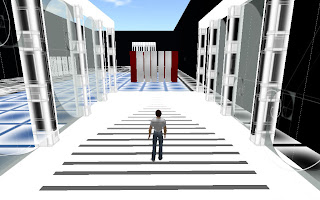the four groups are Mobile, Flexible, Distributed and Virtual.
Mobile
So what is involved with a mobile theme? to me it can mean a few things, obviously i think that mobile architecture can involve the actual structure being able to be transported from location to location, but i think that you can look deeper into what other opportunities and aspects that can come from mobile architecture.
Mobile = connections. I think that having buildings that are transportable could establish a strong connection between Australian citys. Maybe an area of parliament house could travel from city to city to connect with its population? Could this be integrated with the existing network?
Some other aspects of mobile could be:
- International connections
- Packable
- compact efficient design
- hard wearing materials
- movible spaces
Virtual
Virtual architecture is a really interesting topic. Do we really need a floor walls and roof to determine a building or space? or could it be the activity that happens inside of the space be what is really important?Some other aspects of Virtual could be:
- Digital- use of technology throughout the space? maybe this is part of the construction or maybe its just some form of entertainment.
- Connection - I think this is really important when talking about virtual architecture. Are we connected to other buildings? through a network or WiFi?
- Translation between built and virtual form
If I look how this ties back to parliament house, maybe there could be a virtual connection between the politicians and the community? at the moment its all speeches and press conferences but what if there was more of an interactive virtual space at parliament house to increase interaction between the two parties?
Flexible
What is a flexible space? i think that a flexible space can have multiple options for how the space looks, the activities that go on in the space and the type of people that use it. These spaces or building types create a unlimited number of uses, and create some really interesting opportunities for us as designers.
The photo above is of the project "suitcase house" i think that this is a great example of a flexible space as there are so many uses for the building and it is up to the imagination of the people occupying the space to decide what activities will go on in the space. There are fold away walls that can change the orientation of rooms and some services like the kitchen are held below the floor under a trap door.
Some aspects of flexible are could be:
- Flowing flexible building materials.
- Use of technology to increase the flexibility of the spaces.
- Strong connections between spaces but maybe softer appearance of spaces use so the occupiers can decide what its used for?
- Transparent materials to create increased design opportunities.
- movible construction elements and fixtures.
Distribution
The idea of "distribution" could relate to the build form in regards to separating parts of the structure and reforming them into new shapes and functional layouts. We could also look at distribution in relation to the people that are using the building, maybe it relates to separating some groups and forming other groups. This could lead to some interesting interactions between the different parties. for example politicians offices are quite a private spaces but what if for a couple of hours a day their offices were relocated to a public viewing space so the public could see and comment on there everyday actions? i think there are many different ways that we could re arrange buildings that would cause different feelings and experiences of the people using them.





No comments:
Post a Comment